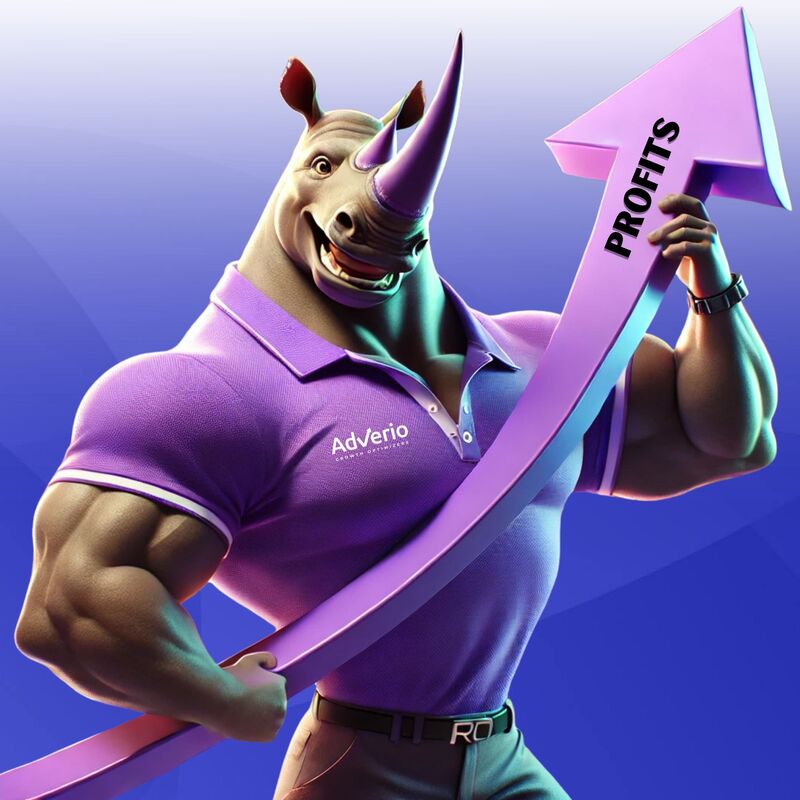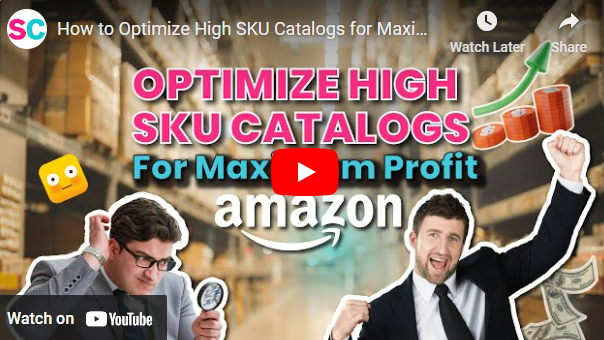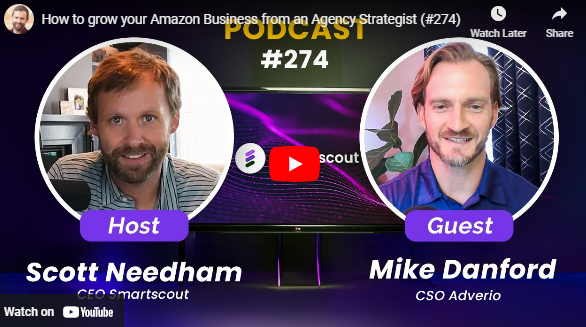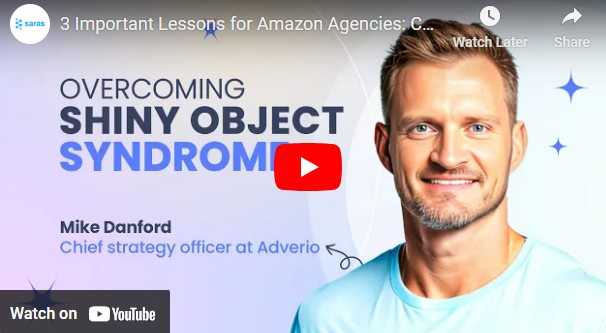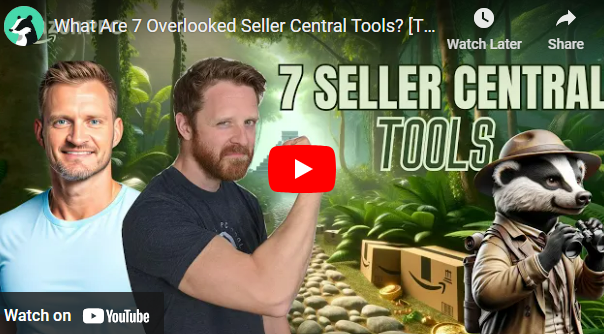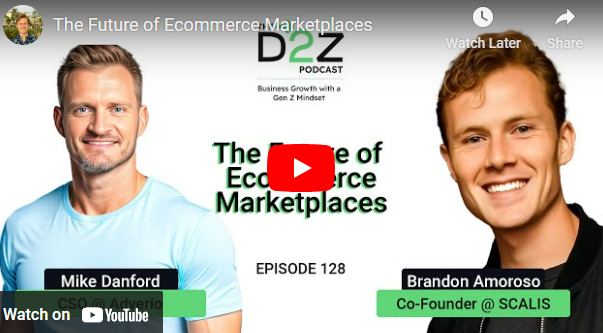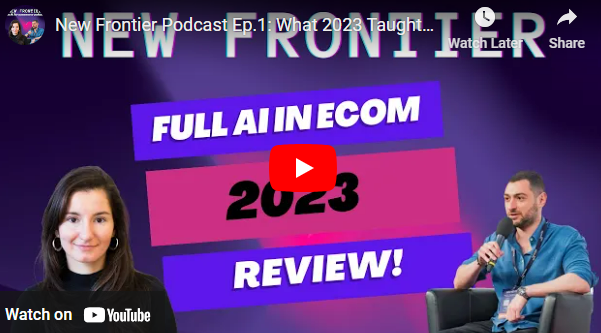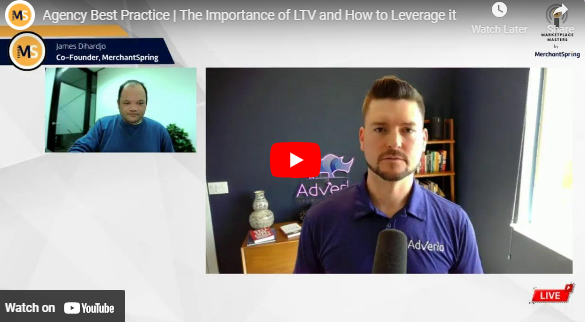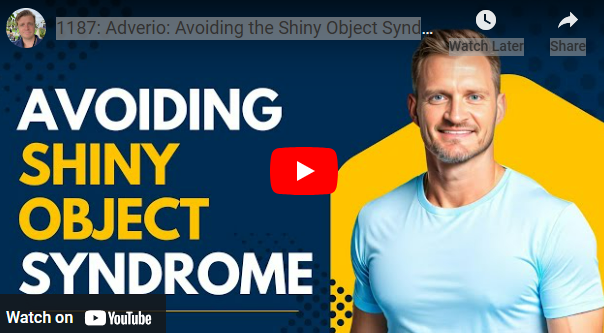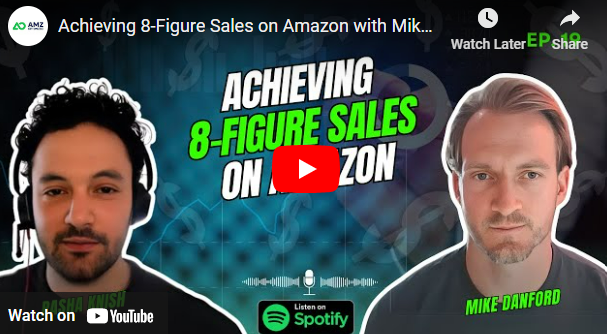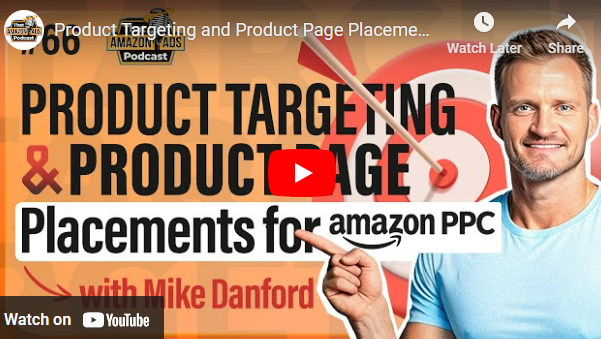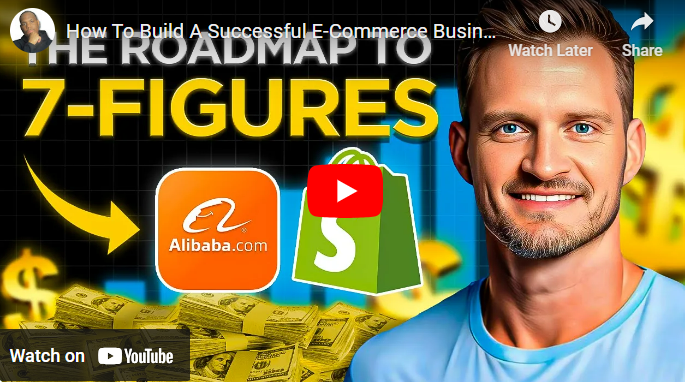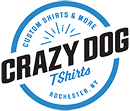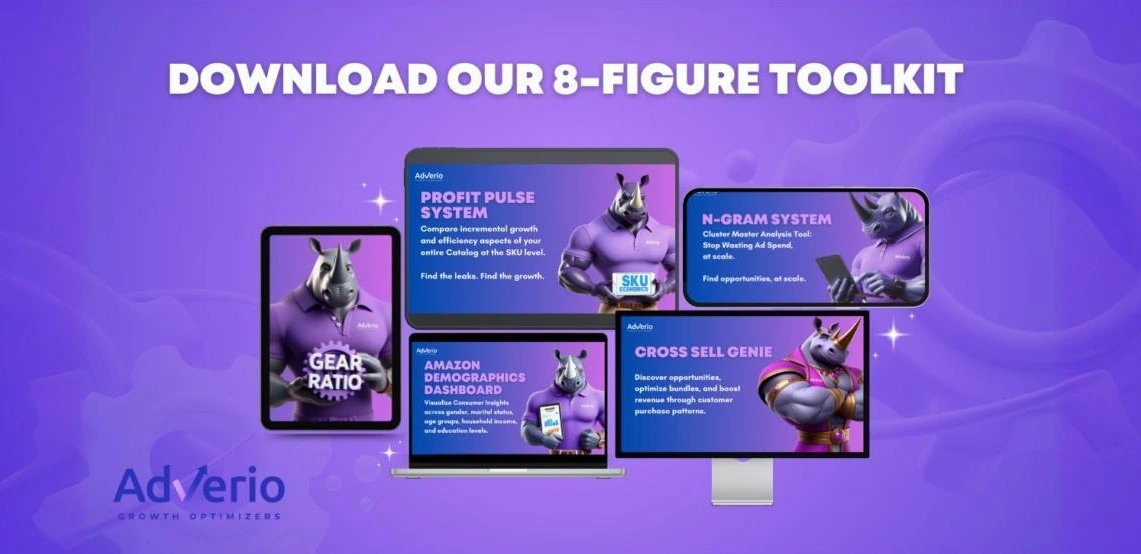The Amazon Strategist Show
The show that's all strategy, no hacks, no silver bullets, and no magic pills. Just real practical strategies for serious Amazon sellers.
In this episode of the Amazon Strategies Show, host John Cavendish chats with Mike Danford, Chief Strategy Officer at Adverio, about managing large catalogs on Amazon. Discover how Mike transitioned from a seller to a service provider and get insights into his ‘Profit Pulse System’ for maintaining thousands of SKUs. Learn about the importance of pricing optimization, the benefits of using specialized tools, and when to choose in-house efforts versus hiring an agency. Tune in for actionable advice on enhancing your Amazon business from an expert with years of experience.
What this podcast covers :
- 00:03 Managing existing campaigns vs creating new campaigns
- 01:58 Scaling up catalog with more SKUs for better profit.
- 03:57 Utilizing the Profit Post System (PPS) for SKU optimization
- 05:51 Optimizing high SKU catalogs requires constant monitoring and adaptation.
- 07:41 Implement Dynamic pricing optimization for cost-effective advertising and sales.
- 09:33 Optimizing pricing for profitability and competitiveness
- 11:22 Brands need to focus on basics for growth
- 13:11 Consider using service providers for reducing learning curve and gaining access to diverse expertise.
- 14:53 Hiring an experienced agency can help optimize high SKU catalogs on Amazon.
- 16:39 Transition from cost-effective to full-service solution for Amazon sellers.
- 18:24 Transitioning to a hybrid approach for creating new campaigns
- 19:52 Adding value with higher skew count catalogs
- Crafted by Merlin AI.00:03 Managing existing campaigns vs creating new campaigns
- 01:58 Scaling up catalog with more SKUs for better profit.
- 03:57 Utilizing the Profit Post System (PPS) for SKU optimization
- 05:51 Optimizing high SKU catalogs requires constant monitoring and adaptation.
- 07:41 Implement Dynamic pricing optimization for cost-effective advertising and sales.
- 09:33 Optimizing pricing for profitability and competitiveness
- 11:22 Brands need to focus on basics for growth
- 13:11 Consider using service providers for reducing learning curve and gaining access to diverse expertise.
- 14:53 Hiring an experienced agency can help optimize high SKU catalogs on Amazon.
- 16:39 Transition from cost-effective to full-service solution for Amazon sellers.
- 18:24 Transitioning to a hybrid approach for creating new campaigns
- 19:52 Adding value with higher skew count catalogs
[00:00:00] Mike Danford: Do you keep the existing campaigns maybe running for a couple of years or do you create new campaigns?
[00:00:11] John Cavendish: Hello, I’m your host John Cavendish and welcome to season three of the Amazon Strategies Show. The show that’s all strategy with no hacks, no silver bullets and no magic pills. Just real practical strategies to sort your Amazon business. So today we have the pleasure of being joined by Mike Danford. Mike is Chief Strategy Officer at Adverio, who most commonly partner with brands with over a thousand SKUs.
So we’re gonna be talking about large catalogs today, which I’m super excited about, and it’s a real differentiator for, what we talk about on this show, so I love that. When he’s not fighting in the trenches, he is working out so that he can eat. And anyone who knows him knows that he is more than happy being surrounded by water, surfing, jet skiing handstanding, whatever that may be.
We’ll get into that later as well. So awesome. Welcome to the show, Mike. Thanks, John. Glad to be here. Cool. Great to have you here. I know we talked previously when we connected about your journey, but could you tell us a little bit about how you ended up where you are right now in the Amazon space?
Sure. I started back in
[00:01:03] Mike Danford: 2014, 2015, went through the ASM, an amazing selling machine, if you’ve been in the space for that long. And So I wanted a small product, had my own brand, and then started doing some retail arbitrage, etc. And I realized that one of my most expensive hires was around PPC and advertising.
And I was like, Hey, this is numerous. I like numbers. Let’s see if I can figure this out. So I did and then started sharing those in groups and others were like, Hey, could you do it for me and we’ll pay you. And obviously the rest is history from there. And then, niched into large catalogs, having started an apparel brand and just started working with other apparel brands.
And the uniqueness that comes with arch catalogs and have
[00:01:42] John Cavendish: Stuck to it since then. Awesome, cool. So I was also ASM. I did ASM 4 back in 15? When everyone thought it was too late and that we’d missed the boat from the 2012 people who got into ASM 1 and were making loads of money back at the time.
Just hilarious. Cool, so you got into larger catalogs and how did that morph from you being a seller to you starting a service? Yeah, so as a seller
[00:02:05] Mike Danford: we had a supplement brand. In the beginning, and then started having some graphic tees, and a lot of funny fitness ing, shirts, etc. I went more D to C on my own websites, before Shopify was popular and common, right?
And then I started doing retail arbitrage, and ironically, timing was reselling Nike shoes. So I would go to their outlets and pick up, hundreds to thousands of their shoes. And just managing inventory out of my small home at the time was a challenge. And then learning just, how do you keep up with the inventory, how does it work etc.
And then I started to realize that, the more SKUs, the more inventory, the more options you have, the less critical if you have returns or thinner margins on a pair of shoes, or you bought the wrong style, or you promoted something that didn’t work, and your margins weren’t as favorable. If you had more and more products, you would have more home runs to go off of.
So just understood that. And then I was, I can communicate with that understanding, having that background personally and on the advertising space, it has definitely changed since 2012, 14, and on the back end of Amazon with ads at a lot more options. And there are some pretty unique ways to go about high multivariant catalogs.
Across the board, even with catalog management, case management, et cetera.
[00:03:20] John Cavendish: That’s been the journey. I love it. That’s super cool. And yeah, we all find our little niches, don’t we? We all find a little part and yes, I like that bit. I’ll do that for and then it somehow it becomes like a career in whatever it may be.
We’ll talk about a bit later, which is, how do you find experts in those specific areas? But before we get into that. With large scale catalogs, like, how do you actually keep your finger on the pulse of what’s going on across all of these SKUs? Sure, that’s a
[00:03:46] Mike Danford: great choice of words there. We actually developed a profit pulse system, or PPS, that we have.
And we actually built that system. It’s a free tool that we can give you a plug to at the end of the episode here. And it just shows a priority. It helps you understand, your ABC groupings. And where they are in terms of, you can look at ROI, margin, ad sales, total sales, there’s lots of different ways you can look at it.
And we brought on a brand about two or three months ago with, I think, around 15, 000 SKUs. And, of course the Pareto, the top 250 or so carry the majority of the weight of the sales. And they come in and our assessment was, there’s probably not much more juice to squeeze from these top 250.
Let’s go and look at the B tier, and that’s what we’ve been pushing for the last month and a half or so. And that tier is growing, and that PPS, that Pulse system we talked about, helps us understand that and say, Hey your advertising is a lot lower relative to your organic or total sales, so you can push here.
Or, hey, you are dumping a lot of cash into a very mature product. Stop doing that. You don’t need to, or where else can we redistribute that, that spend, et cetera. And you go across and you can look at conversion rate from ad conversion versus listing conversion, total listing conversion rate, to understand that the ads are actually helping the listing or hurting the listing.
There’s so much that you can have and it’s a constant battle. It’s, you have to build AI and machine learning into it to help us, not get too neuros nearsighted or narrow. Focused on a few products. And what we’ve come to find out is, Hey the brand has neglected these SKUs at the very bottom of their catalog, and we usually can throw a little spaghetti on the wall and a few things will stick and Hey, all of a sudden we’ve got one going up the ranks and Hey, we haven’t sold this SKU in five years.
How are you selling it as like a number 10 SKU right now? And it’s just the platform changes. The chopper personas changed the market changes, et cetera. If it didn’t work five years ago, sometimes it’ll work more now or better now than it did. So definitely circling back to that. And then, it’s just going through, we have a ton of scores and other metrics from a listing quality score to how problematic is this SKU and how many cases it has.
Is this SKU worth keeping because it’s costing you more in time and trying to fight Amazon and they want to keep, messing up your category nodes, et cetera. So look at the case history. Reviews, et cetera. So it’s a lot but pulling it all together and into your point, keeping that pulse it’s always changing, always
[00:06:09] John Cavendish: changing.
That’s interesting. When you talk about like SKUs that are underperforming or going up, are you looking at them just on the account because you’ve got so many SKUs or are you actually pulling data from the market to figure out where they fit? In the current marketplace, because it’s such a high volume,
[00:06:23] Mike Danford: yeah. For most brands, it’s, you don’t really need to get out into the market until they get into your A tier, which is where they’re doing really well and they’re already selling well. And is it worth, is the juice worth the squeeze to start being more and more granular and pulling in the extra competitor data?
Or, nine times out of ten, it is more cost effective for the brand, for us, and faster to just push what you have and see what will work and get it to its natural state of, balance. As opposed to trying to ink out an extra quarter percent of conversion rate or click through rate and just get that little incremental lift.
Now, once you’ve had that and you’ve maybe doubled the number of ASINs from 250 to 500 that are now carrying the majority of the weight, Then you can go back and do that. But most of the time it’s just chasing your tell when you’re doing that. And it’s fun. Yes, we do optimize the top SKUs.
If it’s this glaring issue of, hey, you’ve got a bunch of negative reviews, let’s work on getting those. Removed or pulling out an old variant that’s pulling down your score. Hey, you’re pricing. So that’s another thing we’ve over the last six months, we’ve really started to pushing dynamic pricing optimization and that has been a lot of fun.
We have SKUs that maybe a low cost SKU, 8 or 9 where advertising is really expensive. It’s already in the top, maybe 10 for a subcategory node. And just, you want to keep it there. So we’ve started doing pricing optimization and deal optimization. I was in charge of the flat fee for the deals.
It’s pretty incredible. We have tons of case studies on that internally that we’re working on. It’s where, Hey, don’t have to, it’s a cost per acquisition model, as opposed to a cost per click model. We’re seeing that with influencer marketing and affiliate marketing and everything as well.
It’s you don’t have to pay until you’ve actually sold. Which is, it’s helpful as the CPC space gets a little more.
[00:08:02] John Cavendish: Totally agree on that. And with pricing optimization are you using, like, how are you doing that? Using an external tool, internal tools? Is that a secret? How are you doing it?
[00:08:10] Mike Danford: Yeah, there’s a few. So we have two competitors. We’re putting them head to head right now. They don’t know about the other, but it is what it is. And one is a lot more visibility for us as more of a managed service. And the other is more I’m sorry, of a self service. And then the other is a managed service.
Different approaches and it’s pretty impressive to be able to pull your competitor data and say, Hey, if you increase your price by this much or decrease your price by this much, this is what the velocity will change and give you your profit projections based on the last 365 days of sales.
Obviously with Prom Day coming up, not sure when this episode will release, but around Prom Day, you can do intra day pricing optimization based on traffic coming to it. If you’re getting a lot more traffic, you can start, generally, push the price up. Obviously try to see how the conversion is. If the conversion fails, you can pull the price down.
So you can squeeze more and more juice in real time around high traffic events. And there’s, that’s just one option. There’s liquidation, there’s BSR protection. There’s all kinds of tactics that can come in.
[00:09:08] John Cavendish: That’s super cool. I didn’t realize you could do that intraday. That’s awesome for profitability on Prime Day.
Or we could do a whole episode about that. But, yeah, that’s really cool. When it comes to your service what do you focus on the most to, to increase your clients profitability, sales, like what do they want to come to you? What do they want when they come to you?
[00:09:28] Mike Danford: Sure.
It’s what’s different. Everyone basically comes to us generally because they have, they want to fix a listing issue or that they’re advertising. They’re not sure if they’re advertising the correct amount in ways, et cetera, or shiny objects in the room. We’re like, I want DSP Hey, let’s check and see if your sponsored ads are actually working.
And you’re leveraging that as much. Yeah. And then you have listing optimization, update my images, update my copy, et cetera. And they all have this no one really comes to us for pricing optimization. So that’s really our uphill battle of, Hey, when’s the last time you changed your prices? That’s been two years or a year ago.
And you’re like, okay, how many times did your competitors will pull a competitor up and say, look at their pricing has changed over time. When you think you’re firing my sales down, look, the competitor’s price is 2 lower. There’s your reason. It’s not your ads. It’s other stuff. It’s holistic approach. That being said, it is difficult with Matt pricing, especially omni channel, as we mentioned at the beginning of the episode here that you have to be careful with the following and not losing your buy box and making sure it syncs across the listings across your platforms, et cetera, especially if you’re using like a Salsify or channel advisor or some kind of omni channel manager.
And that’s definitely a challenge, but I would say that’s a lot of brands. Just need to do more of the basics. They’ve been in a space for 10 or 15 years. They’re a nice mid low seven figure brand. And they’re like, Hey, we’re not growing anymore. Why is that? And then, like I mentioned, we’ll go in and let’s go get some ACEs you haven’t touched in a few years.
Let’s also look at this, look at your product opportunity, explore, look at these other tools that are available inside of Amazon that tells you. Where you’re relative to your competitors and what they’re saying about your competitors versus yours and what your rank is, or why is this particular design outranking us?
There’s so much information Amazon is giving sellers more and more of. However, it’s a lot of information. It’s not the most pretty, it’s very complicated. Sometimes you can’t even export it or you’re limited inside. So we aim to every time they release something typically on the front end before the API is always usually later.
But we work to build as many Google suite tools, docs, sheets, et cetera. And then we give those out for free once we build them, because we know it helps us and it helps others to understand what to look for and use this data and visualize it. So it’s a constant process for sure.
[00:11:39] John Cavendish: Cool.
And like when you talk about omni channel tools, do a lot of your clients come to you already using omni channel tools? Or how does that usually work?
[00:11:46] Mike Danford: Yeah, most of them do. We’ll have a few that’ll come in, maybe they’re doing D2C and they want to get on to Amazon or OneMarketplace or their own Amazon, they want to get on to Walmart.
But most of them, because they have such a large catalog, they need some kind of PIMM down, multi product or high product. Management tool. So they’re already on those and it’s pretty easy to distribute it across other channels just because most of them have integrations.
[00:12:08] John Cavendish: Cool. Maybe we’ll make that into the subject type of, into the episode title, cause I feel like, that’s a very big thing that a lot of people, it’s a good classifier.
You need to be of a certain size or a certain skew count to want to use one of those tools. Because as you said, they can be a real pain. Yeah. As well as a pleasure as well as a benefit.
[00:12:24] Mike Danford: There’s one or two that I’ve just mentioned there that you’re spending more time fixing the issues of the platform that we talked about that before as well.
It’s yeah, you’re fighting the machine, right? So it’s what’s the lesser of two evils,
[00:12:35] John Cavendish: right? Yeah. A hundred percent. How do you decide, or when you were a seller and you were thinking about using service providers, like how did you decide? Whether to do it in house or to use a service provider for different parts of your business.
[00:12:47] Mike Danford: It’s reducing the learning curve. So it’s how do you want to learn it? Do you actually want to learn this? Is your team large enough? Most of the brands I work with, again, mid to seven, mid eight figure brands, they have it and they can have the talent inside. What they come to realize is that even though if you’re a Google or a Shopify or an Amazon expert, it’s really hard to transfer that across to another company.
Marketplace or vertical or sales channel, et cetera. So that’s one part. And then the other is, most people that are internal have maybe worked for one or two brands and they only see a few things, whereas an agency like us, we see hundreds and thousands of brands we get to see, pull all that data together and you can answer your questions a lot faster.
Say, Hey, no don’t do this. We’ve already done that. We’ve already followed the shiny object. Like I mentioned, any new feature that’s released or report comes from Amazon, we’re on it. We’re trying to understand, can you leverage it? How do you leverage it? Does it make sense? A new ad type comes out.
Does it make sense to do that? What’s going on? We get to have that macro lens. I do think that you do need to have, typically a seven figure seller before you pull into an agency. I think it’s just really cost prohibitive to do that. I think you need to understand the brand and understand the marketplace.
You need to learn that whether it’s you or just, a right hand man or woman. To do that before you get in, and then once I think you’re in your seven figures, it does help to speed up that curve, to, to pull in an agency or a different service provider, someone that specifically has experience, typically, And your vertical, that’s definitely helpful as well.
Because what works in one vertical does not work to the other or niche, etc. And then what you get, working with an agency that’s large enough is a bench, right? Say if someone goes out on vacation, like we just had, we had one of our director of operations go out last week. We were able to pull another brand manager in to assist with that.
Or we have someone that’s an expert in a specific type of category or vertical that can come in and tap. And then, we have weekly meetings. There’s three weekly meetings across the different teams that will say, Hey, here’s what I’m seeing on this type of account. Are you seeing this as well? Or how did you do this?
Or, Hey, what we have 30 minutes, every session, you have to have a problem or an issue or a concern. And you have to ask the team chimes in and it just reduces that learning curve for sure. And then, obviously I’m biased. I’m going to be agency first, but I do try to be respectful of that.
When we have prospects come to us and say, Hey, we do tell them you’re not ready. For us, one, cost, it’s not cost effective for you. And two, you need to do a few things in the backend. You need to understand a little more about, what Amazon is, what the features are, it’s really difficult for us to educate or train a brand up that’s fairly new because we can’t talk about product opportunity explorer or these catalog tools and these other things because they don’t have the basic knowledge.
That’s just not what we’re here for. So we usually point them into a direction where someone that’s works more with the go to market brand and can give them that education or point to an education resource for sure.
[00:15:27] John Cavendish: Cool. Yeah, I’d agree with that as well. I think what we did create with Seller Candy is like a stepping stone.
So some people do come to us when they’re earlier on because we are a more cost effective service and you can come out and use us until you get ready for a full service solution, such as yourself or depending on what type of service you need for what area. Yeah. Which is where we like to be. I fully endorse that remark too.
Yes. Thank you. All right. So we have another section of the podcast that we’re going to go into. We have our controversial take. That’s why we call it controversial take. I think Americans would call it hot take. But yeah. So what is your most desi debatable, not desirable, debatable or controversial opinion related to the Amazon or the e commerce industry in general?
Oh man it’s of
[00:16:11] Mike Danford: the week. So we just had one I actually spoke about yesterday and, There’s a lot of chatter since I’ve been in space about with the advertising specifically, do you keep the existing campaigns and maybe run it for a couple of years, or do you create new campaigns? And we’ve been with a brand for a little over four and a half years, and we’ve done as much as we can to retain the original campaigns from four or five years ago, a few things happen.
One, the old campaigns don’t have the new feature, so you have to create new campaigns sometimes. You’re forced to do that. And the second is, yes, there is disruption when you take. And in harvest or move successful targets or whatever, from one campaign to a new campaign. But we just did this across, a six figure spending brand.
It takes about two weeks, and then it comes right back to where it was in terms of traffic, efficiency and velocity as well. So obviously you don’t want to do that all at once. There are some software platforms out there, especially in the advertising space, that require all new campaigns. But I think most of them are starting to switch more to at least a campaign takeover.
So you can migrate and stare that out. But, it is a debate. Previously I was, hey, let’s create new campaigns. Let’s just suck it up for that week or two. But now we’re starting to figure out how to do more of a hybrid approach and how to reduce
[00:17:24] John Cavendish: that disruption. That’s great.
One to two weeks isn’t actually that bad either. I’ve been, I’ve heard in the past it taking a while to get the same kind of traction, but just clarification on that, then would you create both campaigns run the simultaneously? Do you do them on often take a hit? How to, how do you usually do that transfer?
[00:17:39] Mike Danford: That’s a great question. So what we’ve come to find out is the best thing is just to, to pause the source of the traffic. Immediately once you create it, you’re going to mirror the bids You’re going to mirror all the placement settings as many placement settings as you can But you’re going to increase the bids about 40 to 50 percent higher than what the bid was in the existing campaign And then every few days you’re going to taper it back down to where the bid was if you don’t do that boost in the beginning, you don’t get the traction It may take three or four days before it even gets attraction even though it has the same bid The same everything, the same placement.
That’s because that campaign doesn’t have that validity and that signal to Amazon saying this is a good term. So you do have to bid higher. It does not necessarily mean that your CPC is gonna be higher, but it does mean you have to bid higher to get recognition for the keyword. We found that out.
So that’s been our take on it. And we’re working harder to make it work. It’s only a three to four day transition, so we’re
[00:18:29] John Cavendish: trying to figure that out. Cool. I love it. That’s really useful, actionable information. And yeah, that’s what I really like about this episode. We’ve gone into super technical stuff that only be applicable to a small amount of the audience.
And, it’s great that we do that because they’re the people that we want to add value to with higher skew count catalogs. So that’s really cool. All right. That’s basically it for the episode. So if you’ve got a lot of value out of this episode and you want to connect with Mike, what’s the best way for people to reach out to you and Adverio?
[00:18:55] Mike Danford: Sure, yeah. So I put together a little kit for folks here at edverio. io forward slash. Amazon strategists. It’s our eight figure toolkit. As I mentioned multiple times, we’ve built a ton of tools. You have access to this. You have free access to it and we update it regularly. Any new tool that comes out will be in there.
It’s a live Google doc link that you have access to. Does I recommend that obviously you can find us on our website or LinkedIn,
[00:19:19] John Cavendish: et cetera. Perfect. So yeah, go check out, download that toolkit. I checked out already. It looks excellent. And thank you for watching the show. So if you’re watching us on whatever platform, please go like subscribe or mainly just click that light button because it makes us appear higher in the rankings when people search for Amazon and Amazon show.
So thanks so much for being here, Mike, and talk to you again soon.

